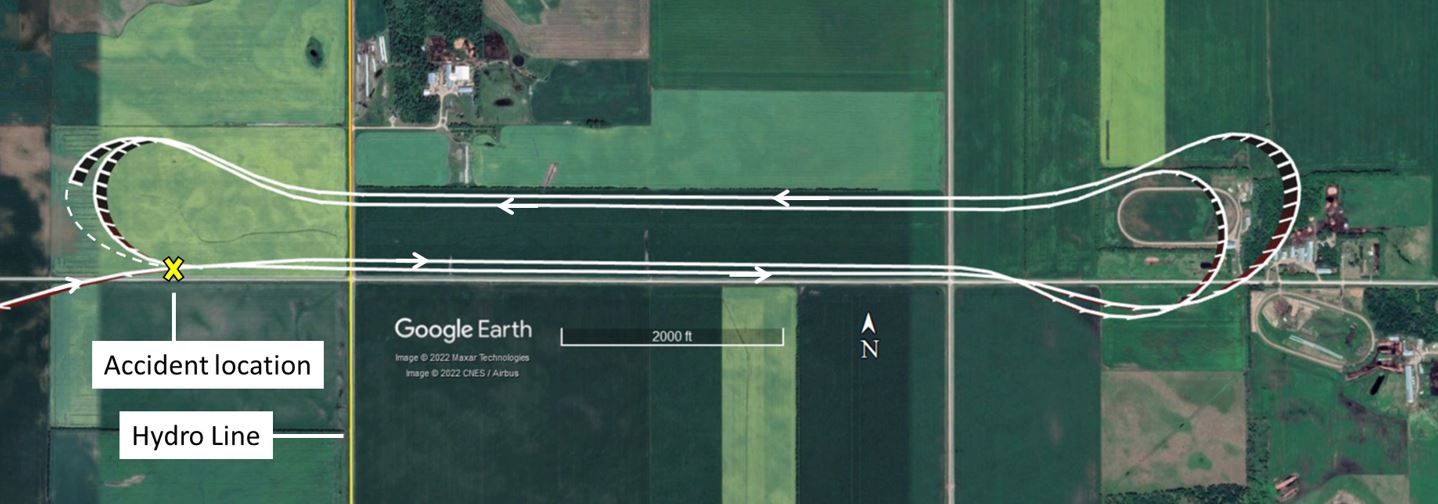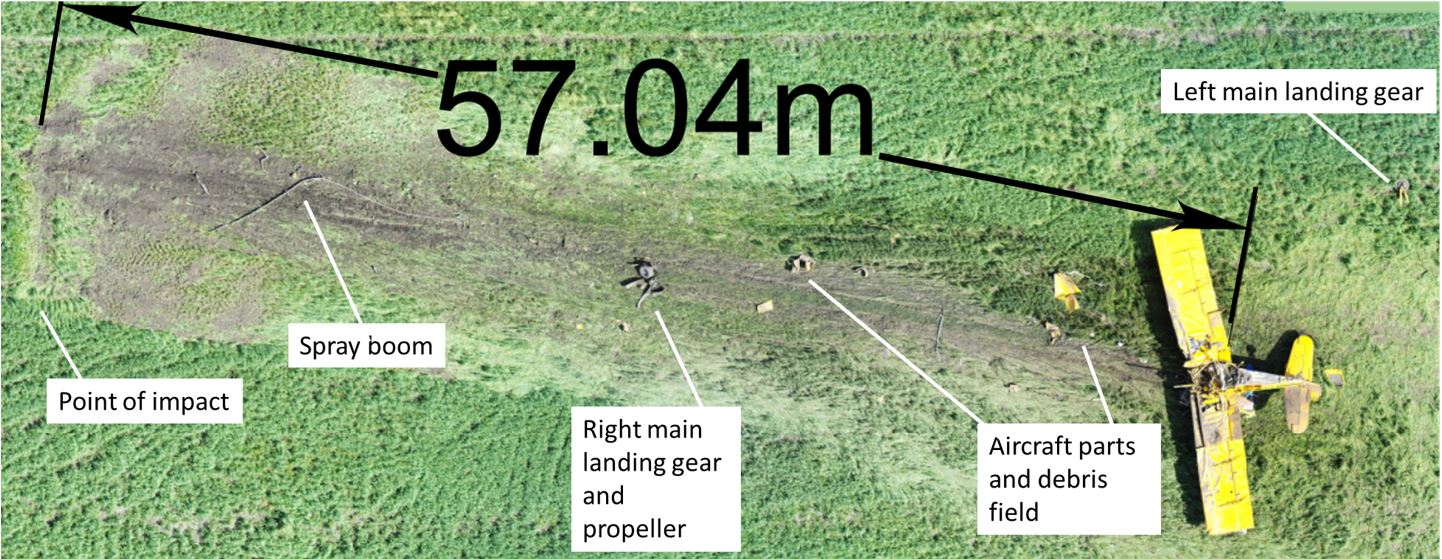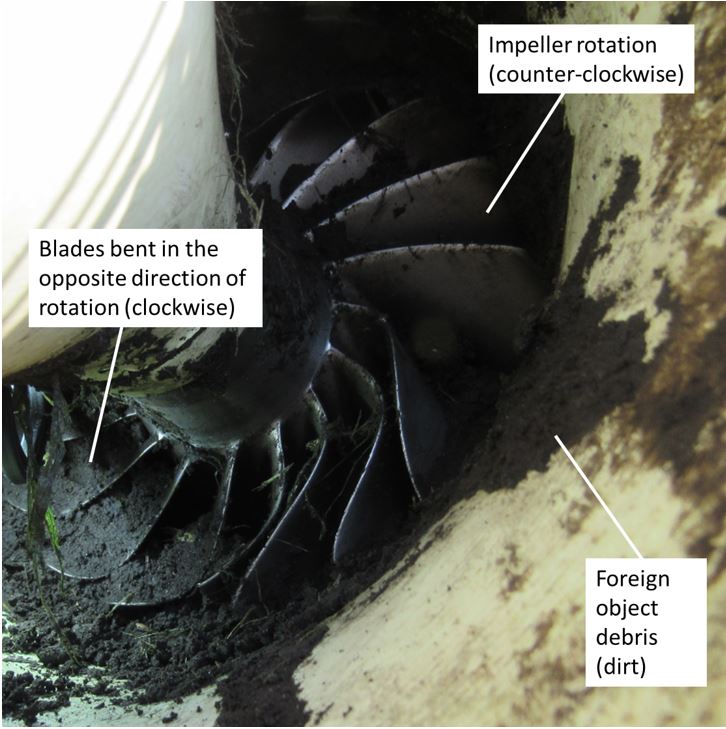Collision with terrain
Pembina Air 1999 Ltd.
Rockwell International, Commander Aircraft Division S-2R, C-GOKD
Treherne (South Norfolk Airpark) Aerodrome, Manitoba, 12 NM NE
The Transportation Safety Board of Canada (TSB) investigated this occurrence for the purpose of advancing transportation safety. It is not the function of the Board to assign fault or determine civil or criminal liability. This report is not created for use in the context of legal, disciplinary or other proceedings. See Ownership and use of content. Masculine pronouns and position titles may be used to signify all genders to comply with the Canadian Transportation Accident Investigation and Safety Board Act (S.C. 1989, c. 3).
History of the flight
At approximately 0858Footnote 1 on 02 August 2022, the Pembina Air 1999 Ltd. Rockwell International, Commander Aircraft DivisionFootnote 2 S-2R aircraft (registration C-GOKD, serial number 2084R) departed Morden Regional Aerodrome (CJA3), Manitoba, for Treherne (South Norfolk Airpark) Aerodrome (CTN6), Manitoba, to conduct a series of aerial applications of a fungicide to crops located around Treherne. The pilot, who was also the owner of the company, flew out of CTN6 for the rest of the day and planned to return to CJA3 when the aerial applications were complete.
Throughout the day, after applying fungicide to a crop, the pilot would return to CTN6, which had a chemical mixing station. Loaders mixed the fungicide and loaded it into the aircraft. The loaders remained at CTN6 while the pilot conducted the aerial application flights. At approximately 1100, the pilot stopped for a break. He resumed flying at approximately 1200 and completed 10 uneventful flights, the last one ending at approximately 1935.
The occurrence flight departed CTN6 at approximately 1950 and the aircraft arrived at the field to be sprayed, located approximately 12 nautical miles (NM) northeast of CTN6, at 2000. The weather was suitable for flight under visual flight rules (VFR). At 2000, an automated weather stationFootnote 3 located at St. Claude, Manitoba (7 NM south-southeast of the occurrence site), recorded the winds as coming from 287° true at 13 knots, gusting to 21 knots. The aircraft conducted 4 runs over the field at approximately 30 feet above ground level and was in a turn to conduct a 5th run when it collided with terrain. The GPS (global positioning system) installed on the aircraft did not record the last moments of the flight (Figure 1).
The emergency locator transmitter activated as a result of the impact and the Joint Rescue Coordination Centre in Trenton, Ontario, received the signal at 2005. The RCMP (Royal Canadian Mounted Police), the Rural Municipality of Grey Fire Department, and provincial emergency medical services responded to the scene. The pilot was fatally injured. The aircraft was destroyed.
Pilot information
The pilot held a commercial pilot licence – aeroplane and his Category 1 medical certificate was valid. His licence was endorsed for single-engine landplanes and seaplanes. The pilot had accumulated approximately 7000 hours of flying time, 1850 hours of which were accumulated flying the occurrence aircraft. On 01 June 2022, the pilot completed his annual training on aerial application techniques and was certified by the Province of Manitoba to carry out aerial application flights.
Aircraft information
The Rockwell International, Commander Aircraft Division S-2R series is a fixed-undercarriage, low-wing, single-engine, tailwheel configuration, agricultural aircraft with a welded steel-tube fuselage.
The occurrence aircraft was manufactured in the United States in 1974, and was imported into Canada in 2012 under a Special Certificate of Airworthiness.Footnote 4
The aircraft was fitted with spraying equipment permitting agriculture work. The hopper was fitted with a dump handle system that allowed its contents to be jettisoned in the event of an emergency.
The aircraft was originally fitted with a radial piston engine. In 2012, before the aircraft was imported into Canada, it was fitted with a GarrettFootnote 5 turbine engineFootnote 6 in accordance with Supplemental Type Certificate (STC) SA5953NM.Footnote 7 The occurrence engine was installed on the aircraft on 06 July 2016.Footnote 8 Before it was installed, the engine compressor and hot section were inspected and numerous Airworthiness Directives (AD) were completed, including, but not limited to, AD 2015-18-03,Footnote 9 which required the replacement of the propeller shaft coupling. The engine was installed with 2077 hours time since overhaul (TSO) and, before 02 August 2022, the engine had accumulated 3545.7 hours TSO (1468.7 hours since installation). The engine drove a 4-bladed, constant-speed, reversing propeller manufactured by Hartzell Propeller Inc.Footnote 10
The aircraft was equipped with a GPSFootnote 11 that recorded aircraft position and altitude, as well as spray boom off/on indications. The aircraft was also equipped with a multiplexer.Footnote 12 The multiplexer was sent to the TSB Engineering Laboratory in Ottawa, Ontario, for analysis. The multiplexer was capable of recording multiple parameters; however, the recorder was set to record only the engine’s interstage turbine temperature.
On 21 July 2022, a 200-hour airframe inspection was completed per the Pembina Air Service maintenance schedule and the S-2R and AlliedSignal/Honeywell work sheets. The aircraft had flown 74 hours since that inspection, and no abnormalities were reported.
Before the occurrence flight, the aircraft had accumulated 7773.0 hours total air time.
The aircraft flight manual listed the occurrence aircraft’s maximum take-off weight (MTOW) as 6000 pounds (2721 kg). However, the aircraft had an exemption from subsection 605.03(1)(b) and section 602.07 of the Canadian Aviation Regulations (CARs) that allowed the aircraft to be operated at a higher gross weight for aerial dispersion. In accordance with the exemption, the aircraft was permitted to be operated at an MTOW of 9120 pounds (4137 kg).
Accident site and wreckage examination
The aircraft collided with soft, level terrain at 49°46'14.80" N, 098°23'58.98" W in a shallow right-wing-low attitude on an easterly heading. Impact marks indicated the wings, landing gear, and propeller contacted the terrain. The aircraft bounced and continued to slide for 57.04 m (Figure 2) before coming to rest with the cockpit, fuselage, and empennage becoming inverted on top of the hopper and engine assembly.
All components of the aircraft were present at the accident site. TSB investigators observed signs of fuel spillage and engine rotation at the time of impact. The wreckage trail consisted of the spray boom, propeller, right main landing gear assembly, pieces of cowling, and pieces of fibreglass material. There was no fire. Flight control continuity was verified. There were no signs of a bird strike or wire strike.
The engine remained attached to its mount and connected to the aircraft. The flaps were in the UP position. The investigation was unable to determine if the fungicide was jettisoned before the impact due to extensive structure damage, including to the hopper dump handle linkage.
Engine examination
TSB investigators conducted an engine inspection, which revealed that the engine was producing power at the time of impact. The starter generator was removed and the starter generator input shaft was found to be sheared in overload. A visual inspection of the engine inlet revealed that the first stage impeller blades were bent in the opposite direction of rotation (Figure 3). The engine was subsequently sent to Honeywell in Phoenix, Arizona, United States, for an engine teardown inspection, which was attended by a TSB investigator. The inspection confirmed that the engine was producing power at the time of the accident and there were no pre-impact failures.
Propeller examination
The propeller had separated from the engine propeller flange and all 4 propeller blades remained attached to the propeller hub. All 4 propeller blades were bent. The propeller was sent to Hartzell for further examination. No pre-impact anomalies were noted that indicated abnormal propeller operation before the impact. Propeller hub piston impact marks representing a blade angle of 21.5° were noted, which is consistent with the propeller operating with moderate power at the time of impact.
Aerial application
According to the product data sheet for the fungicide being applied, certain precautions are required when conducting aerial application. For example, the product must not be sprayed when winds are calm, gusty, or at a speed greater than 8.6 knots at the flying height. The product data sheet also includes ground crew precautions, such as personal protective equipment and clothing to be worn. It also indicates that pilots must not be allowed to mix the chemicals to be loaded into the aircraft.Footnote 13 This product is considered a serious eye irritant.
The investigation determined that loaders mixed and loaded the chemicals for the aircraft; however, the investigation was unable to determine if the pilot followed the other precautions listed on the product data sheet.
TSB laboratory reports
The TSB completed the following laboratory reports in support of this investigation:
- LP078/2022 – NVM Recovery – Multiplexer
- LP003/2023 – Dynaflight Data Recovery and Analysis
Safety messages
The investigation could not determine the complete sequence of events that led to this collision with terrain. The occurrence aircraft was equipped with an engine monitoring system, which provided some information to the investigation; however, it was not equipped with a lightweight data recorder, nor was it required to be by regulation. The information recorded by lightweight data recorders can be helpful to determine what happened in an accident.
In this occurrence, the pilot was conducting aerial application flights involving a fungicide that requires certain precautions to be followed when using. Pilots are reminded of the importance of following all instructions provided on the chemical’s product data sheet.
This report concludes the Transportation Safety Board of Canada’s investigation into this occurrence. The Board authorized the release of this report on . It was officially released on .


